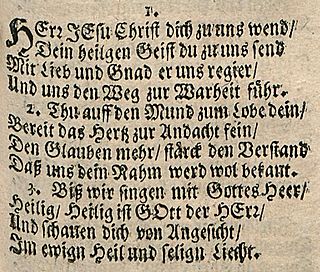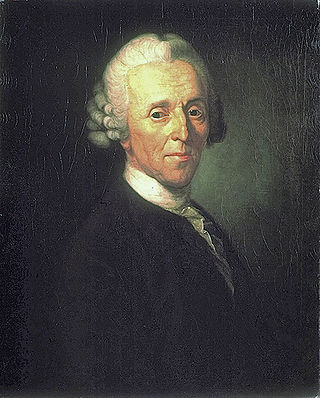Related Research Articles

"Be Thou My Vision" is a traditional Christian hymn of Irish origin. The words are based on a Middle Irish poem that has traditionally been attributed to Dallán Forgaill.

"For All the Saints" was written as a processional hymn by William Walsham How, who was ultimately the Anglican Bishop of Wakefield. The hymn was first printed in Hymns for Saints' Days, and Other Hymns, by Earl Nelson, 1864.

"Just as I Am" is a well-known hymn, written by Charlotte Elliott in 1835, first appearing in the Christian Remembrancer, of which Elliott became the editor in 1836. The final verse is taken from Elliott's Hours of Sorrow Cheered and Comforted (1836).

"Herzliebster Jesu" is a Lutheran Passion hymn in German, written in 1630 by Johann Heermann, in 15 stanzas of 4 lines, first published in Devoti Musica Cordis in Breslau. As the original headline reveals, it is based on Augustine of Hippo; this means the seventh chapter of the so-called "Meditationes Divi Augustini", presently ascribed to John of Fécamp.

"O Sacred Head, Now Wounded" is a Christian Passion hymn based on a Latin text written during the Middle Ages. Paul Gerhardt wrote a German version which is known by its incipit, "O Haupt voll Blut und Wunden".
Bartholomäus Ringwaldt was a German didactic poet and Lutheran pastor. He is most recognized as a hymnwriter.
Robert Hall Baynes was an Anglican priest, a hymnodist and a hymn writer. He was editor of the Lyra Anglicana, which was among the most influential hymnals of the Oxford Movement in the 1860s and 1870s, having a relatively broad selection of Anglican authors.

"Herr Jesu Christ, dich zu uns wend" is a Lutheran hymn from the 17th century. Its hymn tune, Zahn No. 624, was adopted in several compositions. It was translated into English and is part of modern hymnals, both Protestant and Catholic.
"Herr Jesu Christ, wahr Mensch und Gott" is a Lutheran hymn by Paul Eber. It is a hymn for the dying. One of the hymn's tunes, Zahn No. 423, is also used for "Wir danken dir, Herr Jesu Christ".

"Allein Gott in der Höh sei Ehr" is an early Lutheran hymn, with text and melody attributed to Nikolaus Decius. With the reformers intending church service in German, it was intended as a German version of the Gloria part of the Latin mass, used in almost every service. Decius wrote three stanzas, probably in 1523, while a fourth was added, probably by Joachim Slüter.
"Herr Jesu Christ, du höchstes Gut" is the beginning of two Lutheran hymns. One is a penitential hymn, written in 1588 by Bartholomäus Ringwaldt, who possibly also created the melody. The other is an anonymous communion hymn, probably based on the former, which appeared first in 1713. Johann Sebastian Bach's used the penitential hymn several times, including the chorale cantata Herr Jesu Christ, du höchstes Gut, BWV 113, based on the hymn.

"In dich hab ich gehoffet, Herr" is a Lutheran hymn in seven stanzas, written by Adam Reusner and first published in 1533. He paraphrased the beginning of Psalm 31. It was first sung to the melody of a Passion hymn. The melody connected with the hymn in 1560 was derived from models dating back to the 14th century. A third melody from 1608 became a hymn tune for several other songs and translations to English. In the German Protestant hymnal Evangelisches Gesangbuch, the hymn appears as EG 257 with the second melody. Johann Sebastian Bach used the second and third melodies in chorale preludes, and the third also in cantatas and the St Matthew Passion.

"Macht hoch die Tür" is a popular German Advent hymn, written in 17th century Ducal Prussia. The lyrics were written by Georg Weissel in 1623 for the inauguration of the Altroßgärter Kirche in Königsberg. The melody that is now associated with the text appeared first in 1704 in the hymnal by Johann Anastasius Freylinghausen.

"Liebster Jesu, wir sind hier" is a Lutheran hymn with text written by Tobias Clausnitzer in 1663, and a hymn tune, Zahn No. 3498b, based on a 1664 melody by Johann Rudolph Ahle. A prayer for illumination, it is suitable for the opening of a church service and to be sung before a sermon. The song is part of the Protestant hymnal Evangelisches Gesangbuch as EG 161. It is also part of the Catholic hymnal Gotteslob as GL 149. It is popular also in English translations such as "Blessed Jesus, at your word" by Catherine Winkworth.
Jesu, meines Glaubens Zier is a German Lutheran hymn by Gottfried Wilhelm Sacer, first published in 1661. Its hymn tune, Zahn No. 6453, was first published in 1714, in Freylinghausen's hymnal. In 1736 the hymn was adopted in Schemellis Gesangbuch, with a figured bass accompaniment which may have been contributed by Johann Sebastian Bach (BWV 472).

"O Jesu Christe, wahres Licht" is a Lutheran hymn by the German Baroque poet, Lutheran minister and hymn-writer Johann Heermann. The text was first published in 1630 during the Thirty Years' War. It is a prayer for enlightenment of those who are ignorant, and of those who turned away. It was associated with a melody from Nürnberg, dating to 1676. The hymn is part of modern German hymnals, both Protestant and Catholic. It was translated to English as "O Christ, our true and only light".
"Morgenglanz der Ewigkeit" is a Christian hymn with German text originally by Christian Knorr von Rosenroth, written around 1690 and set to music for private devotion. It became known with a 1662 melody by Johann Rudolf Ahle. The song is part of modern German hymnals and songbooks. It was translated to English as "Come, Thou Bright and Morning Star", and as "Dayspring of Eternity".

"Herr, stärke mich, dein Leiden zu bedenken" is a Passion hymn in German, written by Christian Fürchtegott Gellert to the melody of "Herzliebster Jesu", and first published in 1757. It is contained in the German Protestant hymnal Evangelisches Gesangbuch.

"Dejlig er jorden" is a Nordic religious hymn. The hymn is usually sung during Christmas.
References
- ↑ "Schönster Herr Jesu". The Canterbury Dictionary of Hymnology. 2013. Retrieved 2022-10-22.
- ↑ Reynolds, William Jensen (1976). Companion to BAPTIST HYMNAL . Nashville: Broadman Press. p. 64. ISBN 0-8054-6808-0.
- ↑ "Take a Listen to the Opening Song from Disney's 'Frozen' [UPDATE]". Rotoscopers. 2013-09-13. Retrieved 2019-12-02.
- ↑ "Fairest Lord Jesus". www.hymntime.com.
- ↑ Schönster Herr Jesu lyrik-und-lied.de. Retrieved: January 8, 2014.
- ↑ Dejlig Er Jorden da.wikisource.org. Retrieved: January 8, 2014.
- ↑ Fair Is Creation www.hymnary.org. Retrieved: January 8, 2014.
- ↑ Fairest Lord Jesus hymntime.com. Retrieved: January 8, 2014.
- ↑ Fairest Lord Jesus hymnary.org. Retrieved: February 10, 2015.